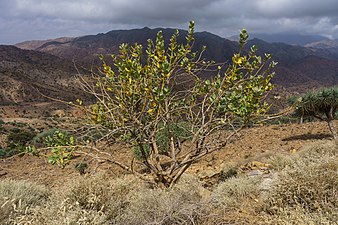Oscher
| Oscher | ||||||||||||
|---|---|---|---|---|---|---|---|---|---|---|---|---|

Oscher ( Calotropis procera ) |
||||||||||||
| Systematics | ||||||||||||
|
||||||||||||
| Scientific name | ||||||||||||
| Calotropis procera | ||||||||||||
| ( Ait. ) R.Br. |
The oscher ( Calotropis procera (Aiton) WTAiton , syn .: Asclepias procera Aiton , Asclepias gigantea Jacquin non L. ), also called fat-leaf tree, is a plant species in the subfamily of the silk plant family (Asclepiadoideae) within the family of the dog-poison plants (Apocynaceae). Its fruit is also known as the Sodomian apple and is not to be confused with the Sodomian apple plant from the nightshade genus .
description
Calotropis procera is a shrub or small tree that reaches heights of 1 to 6 m. It contains white milky juice . The against-constantly and dekussiert on the branches arranged leaves are simple, hairy matted. The leaf blade is 70 to 205 mm long and 55 to 150 mm wide. The leaf margins are smooth. If there are petioles, then they are a maximum of 4 mm long.
The branched inflorescences are complex. The flower stalk is 20 to 32 mm long. The hermaphrodite, radially symmetrical flowers are five-fold. The five free sepals are 4 to 8 mm long. The five outside cream-colored, white and inside violet petals are 10 to 18 mm long and only fused at the base. There is only one circle with five stamens . Two carpels are a top permanent ovary fused with two punches which are grown up, thereby is only a scar present. The stamens are fused with each other, with the petals and the two pistils; Filaments and pistil together form a column. The flowering period extends from January to December, so it is all year round.
The apple-like, dry fruit (consists of two follicles ) has a diameter of about 70 mm, is 100 to 120 mm long and contains many seeds. The seeds have a tuft of long, silky hair as flight organs and have a size of about 6 × 4 mm.
The number of chromosomes is 2n = 22.
Occurrence
The species is native to Macaronesia and North Africa and from tropical Africa to Indochina. It is grown in many countries and occurs wild.
Apple from Sodom
The Roman-Jewish historian Flavius Josephus mentions in his work The Jewish War , in the landscape around the "asphalt lake" (the Dead Sea ), which he equates with the biblical Sodom , fruits still grow as a result of the biblical catastrophe, the shell that would resemble that of edible fruits, but the interior of which dissolves into smoke and ashes after being picked. This literature reference was later repeatedly referred to the Oscher. As the “apple of Sodom” it has been interpreted allegorically , especially by theological writers . However, the plant itself is not mentioned in the Bible .
use
Parts of the plant, especially the bark and leaves, are used medicinally. The shepherds of the Fulbe in West Africa use the leaves to curdle milk to make soft cheese (in northern Nigeria warankasi ).
The wood is light, light and soft. It is used as fuel and for building houses. The wood was previously used by nomads in the western Sahara for wooden sandals and milking jars. Ropes can be made from the bark. In Mauritania , the nomads used the dry flakes of the fruit until about the middle of the 20th century to use it as tinder to make fire. The plant is called in Hassania turǧaīye ( Pl . Turǧe ).
The seed fibers are used as akon .
photos
Habit at the natural site: Afar region , Ethiopia
Sugar bird ( Coereba flaveola ) on an oscher taking in nectar
literature
- B. Richardson: Calotropis procera (Aiton) WTAiton Calotrope. Western Australian flora
- Bingtao Li, Michael G. Gilbert & W. Douglas Stevens: Asclepiadaceae . Calotropis procera . In: Flora of China , Volume 16, p. 203
Individual evidence
- ↑ Calotropis procera at Tropicos.org. In: IPCN Chromosome Reports . Missouri Botanical Garden, St. Louis
- ↑ a b Rafaël Govaerts (Ed.): Calotropis - World Checklist of Selected Plant Families of the Royal Botanic Gardens, Kew. Last accessed on November 4, 2017.
- ↑ Michael Zohary : Plants of the Bible. Calwer Verlag, Stuttgart 1983. ISBN 3-7668-0724-2 , 2nd apple from Sodom on page 122.
- ^ Wolfgang Creyaufmüller: Nomad culture in the Western Sahara. The material culture of the Moors, their handicraft techniques and basic ornamental structures. Burgfried-Verlag, Hallein (Austria) 1983, ISBN 3-85388-011-8 , pp. 127, 269, 364.
Web links
- Calotropis procera . In: U. Brunken, M. Schmidt, S. Dressler, T. Janssen, A. Thiombiano, G. Zizka: West African plants - A Photo Guide. Senckenberg Research Institute, Frankfurt am Main 2008.
- Entry in the Flora of Zimbabwe. (engl.)
- Information on poisonous and medicinal effects. (engl.)



